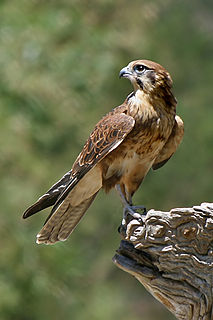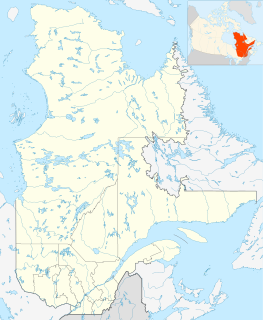
Falcons are birds of prey in the genus Falco, which includes about 40 species. Falcons are widely distributed on all continents of the world except Antarctica, though closely related raptors did occur there in the Eocene.

The peregrine falcon, also known as the peregrine, and historically as the duck hawk in North America, is a widespread bird of prey (raptor) in the family Falconidae. A large, crow-sized falcon, it has a blue-grey back, barred white underparts, and a black head. The peregrine is renowned for its speed, reaching over 320 km/h (200 mph) during its characteristic hunting stoop, making it the fastest bird in the world, as well as the fastest member of the animal kingdom. According to a National Geographic TV program, the highest measured speed of a peregrine falcon is 389 km/h (242 mph). As is typical for bird-eating raptors, peregrine falcons are sexually dimorphic, with females being considerably larger than males.

Falconry is the hunting of wild animals in their natural state and habitat by means of a trained bird of prey. Small animals are hunted; squirrels and rabbits often fall prey to these birds. Two traditional terms are used to describe a person involved in falconry: a "falconer" flies a falcon; an "austringer" flies a hawk or an eagle. In modern falconry, the red-tailed hawk, Harris's hawk, and the peregrine falcon are some of the more commonly used birds of prey. The practice of hunting with a conditioned falconry bird is also called "hawking" or "gamehawking", although the words hawking and hawker have become used so much to refer to petty traveling traders, that the terms "falconer" and "falconry" now apply to most use of trained birds of prey to catch game. Many contemporary practitioners still use these words in their original meaning, however.

The saker falcon is a large species of falcon. This species breeds from central Europe eastwards across the Palearctic to Manchuria. It is mainly migratory except in the southernmost parts of its range, wintering in Ethiopia, the Arabian peninsula, northern Pakistan and western China. The saker falcon is the national bird of Hungary, United Arab Emirates, and Mongolia.

The Falcon 1 was an expendable launch system privately developed and manufactured by SpaceX during 2006–2009. On 28 September 2008, Falcon 1 became the first privately-developed liquid-fuel launch vehicle to go into orbit around the Earth.

The prairie falcon is a medium-large sized falcon of western North America. It is about the size of a peregrine falcon or a crow, with an average length of 40 cm (16 in), wingspan of approximately 1 meter (40 in), and average weight of 720 g (1.6 lb). As in all falcons, females are noticeably bigger than males. Though a separate species from the peregrine, the prairie falcon is basically an arid environment adaptation of the early peregrine falcon lineage, able to subsist on less food than the peregrine, and generally lighter in weight than a peregrine of similar wing span. Having evolved in a harsh desert environment with low prey density, the prairie falcon has developed into an aggressive and opportunistic hunter of a wide range of both mammal and bird prey. It will regularly take prey from the size of sparrows to approximately its own weight, and occasionally much larger. It is the only larger falcon native only to North America. It is resident from southern Canada, through western United States, and into northern Mexico. The prairie falcon is popular as a falconry bird, where with proper training it is regarded as being as effective as the more well known peregrine falcon.

Vuntut National Park is a national park located in northern Yukon, Canada. It was established in 1995 as part of the Vuntut Gwitchin First Nation Final Agreement, to conserve, protect and present to Canadians a portion of the North Yukon Natural Region, to recognize Vuntut Gwitchin history and culture, and to protect the traditional and current use of the park by the Vuntut Gwitchin. The name Vuntut comes from the Gwichʼin for among the lakes. Fewer than 25 people visit the park each year.

Wyvernhail is the fifth book in the Kiesha'ra Series by Amelia Atwater-Rhodes. The preceding four books in order are: Hawksong, Snakecharm, Falcondance, and Wolfcry. It is told from the point of view of Hai the gyrfalcon, cobra mix, who is struggling to find a way out of Ecl, or the darkness.
The Altai falcon is a large falcon of questionable taxonomic position. It is often considered to be a subspecies of the saker falcon. It used to have a high reputation among Central Asian falconers. It is uncertain whether the bird is a saker subspecies or a hybrid.

The Air Force Falcons are the athletic teams that represent the United States Air Force Academy. The intercollegiate program has 17 men's and 10 women's NCAA-sanctioned teams. The current athletic director is Nathan Pine. The majority of the Falcons teams compete as members of the Mountain West Conference.
The gyrfalcon is the largest of the falcon species..
Chelmer Valley High School (CVHS) is an academy based on a large site on the outskirts of Chelmsford, Essex, England. It has specialisms in engineering, and is assessed as one of the best performing comprehensive schools in Essex; it was given an "outstanding" rating by Ofsted in 2007, and as "good" in 2013. The school also received an Ofsted rating of "good" in 2017.
The Peregrine Fund is a non-profit organization founded in 1970 that conserves threatened and endangered birds of prey worldwide. The successful recovery in the United States of the peregrine falcon, which was removed from the U.S. Endangered Species List in 1999, enabled the organization to expand its mission to include other endangered raptors around the world. The Peregrine Fund is headquartered at its World Center for Birds of Prey in Boise, Idaho, on a 580-acre (2.3 km2) campus with breeding and research facilities, an administrative office, interpretive center, research library, and archives.

The Gyrfalcon Islands are an uninhabited island group in the Qikiqtaaluk Region of Nunavut, Canada. The over 200 small islands form an archipelago in western Ungava Bay north of Quebec's Ungava Peninsula and 19.7 km (12.2 mi) northeast of Leaf Bay. Tiercel Island and Qikirtajuaq Island lie to the southwest. The closest community is the Inuit village of Kuujjuaq, 120 km (75 mi) to the southeast.

The gyrfalcon, the largest of the falcon species, is a bird of prey. The abbreviation gyr is also used. It breeds on Arctic coasts and tundra, and the islands of northern North America and the Eurosiberian region. It is mainly a resident there also, but some gyrfalcons disperse more widely after the breeding season, or in winter. Individual vagrancy can take birds for long distances. Its plumage varies with location, with birds being coloured from all-white to dark brown. These colour variations are called morphs. Like other falcons, it shows sexual dimorphism, with the female much larger than the male. For centuries, the gyrfalcon has been valued as a hunting bird. Typical prey includes the ptarmigan and waterfowl, which it may take in flight; it also takes fish and mammals.

The natural environment of Virginia encompasses the physical geography and biology of the U.S. state of Virginia. Virginia has a total area of 42,774.2 square miles (110,784.67 km2), including 3,180.13 square miles (8,236.5 km2) of water, making it the 35th-largest state by area. Forests cover 65% of the state, wetlands and water cover 6% of the land in the state, while 5% of the state is a mixture of commercial, residential, and transitional.
Geier is a German word for a vulture. Geier is also a notable surname and less frequently is seen as a place name.

SpaceX manufactures launch vehicles to operate its launch provider services and to execute its various exploration goals. SpaceX currently manufactures and operates the Falcon 9 Full Thrust family of medium-lift launch vehicles and the Falcon Heavy family of heavy-lift launch vehicles – both of which powered by SpaceX Merlin engines and employing VTVL technologies to reuse the first stage. As of 2020, the company is also developing the fully reusable Starship launch system, which will replace the Falcon 9 and Falcon Heavy.

Akdoğan is a village in the District of Kızılcahamam, Ankara Province, Turkey. As of 2000, it had a population of 306 people.













